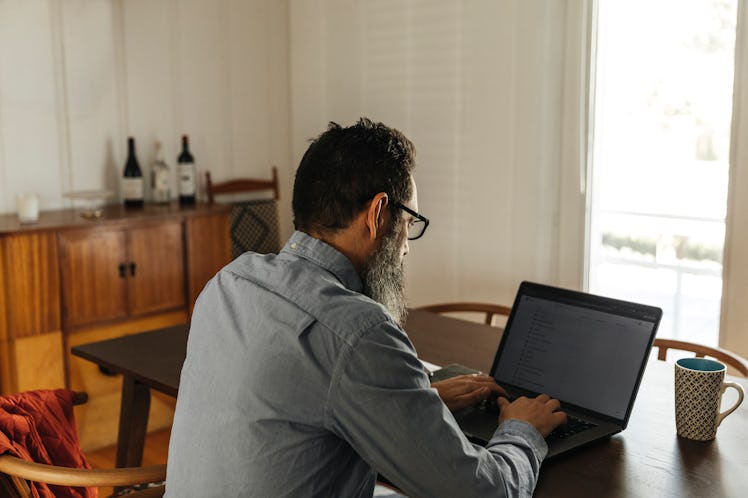Do Blue Light Blocking Glasses Work? Experts Say It's A Mixed Bag
Experts say the health promises of blue light glasses are overblown.

There are a lot of promises wrapped up in blue light blocking glasses, from reduced eye strain to clearer vision, preventing retina damage, or even helping you get better sleep. Do they live up to the hype? At the end of the day, experts says blocking blue light isn’t a cure-all and that the evidence on the effectiveness of blue light blockers isn’t all that clear.
Many people reach for blue light glasses in hopes they’ll lessen digital eye strain, a condition which affects 58% of U.S. adults and is characterized by dry, itchy eyes, headaches, and blurred vision. Eye strain occurs when you stare at something for a long time, close up, without blinking, which forces the eyes to work harder to focus and prevents normal tear distribution.
According to the American Academy of Ophthalmology (AAO), humans generally blink around 15 times per minute. But when staring at something close up, we tend to blink half as many times. “It could happen from reading a book, anything you’re staring at,” says William Reynolds, O.D., president of the American Optometric Association. However, Reynolds notes that computer screens are more difficult to look at than books, since “it’s not a solid stimulus. It’s a stimulus that flickers very, very quickly.”
What does this have to do with blue light? Not very much.
Sure, computers emit blue light, but far less than the amount present in sunlight. Eye strain has more to do with how we use computers, staring at them for long periods of time without break, than the nature of computers themselves.
To prevent strain, Reynolds recommends the 20-20-20 rule: every 20 minutes, look somewhere 20 feet away for 20 seconds. Reynolds also advises people to keep a comfortable distance from a screen, since the closer you are, the harder your eyes have to work to focus. If you wear glasses, Reynolds says you should make sure you have the right lenses for the right distance.
“Quantifying eye fatigue is a somewhat difficult thing to measure,” Reynolds says. “To be honest, the jury’s still out.” A 2017 literature review concluded that “there is a lack of high quality clinical evidence for a beneficial effect of blue‐blocking spectacle lenses in the general population to improve visual performance or sleep quality, alleviate eye fatigue or conserve macular health.”
There may, however, be some hope for the benefits of blue light glasses. The claim that blue light disrupts melatonin production and makes it harder to get some sleep has some merit. “Our bodies kind of associate blue light with daytime,” Reynolds says. The AAO cites a 2015 study that found that the use of e-readers (i.e. reading by screen) before bed was associated with lower levels of melatonin, leading to an additional 10 minutes to fall asleep, less REM sleep, and feeling more tired in the morning.
The problem? Whether blue light glasses prevent this is unclear.
Studies investigating blue light glasses and sleep have small sample sizes, aren’t randomized, and show mixed results. Take the 2019 study that found that the use of blue light blocking glasses led to 44 minutes of additional sleep and reduced anxiety and depression for people with insomnia undergoing cognitive behavioral therapy. Though the results are compelling, the sample size is only 30 people, all of whom have insomnia, and the study isn’t randomized. A 2017 study that found amber-colored glasses improved quality of sleep, decreased insomnia symptoms, and led to earlier wake times was randomized, but only included 15 participants.
Furthermore, blue light glasses aren’t the only way to limit blue light. Regular high-quality sunglasses also block blue light since they’re designed to block sunlight, which contains far more blue light than that given off by a computer screen. Another option is putting your device on night mode, a setting that gives the screen a slight amber color. Of course, limiting exposure to screens works too, and is advice sleep experts give for the pre-bedtime hours anyway.
There’s no evidence that children’s eyes respond differently to blue light than adults eyes. But Reynolds points out that rates of myopia, or nearsightedness, have increased in recent decades, a trend he attributes to increasing use of screens. “The nearsightedness was around 25% of the United States in the 1980s. And now it’s up to around 40%,” Reynolds says.
He attributes this to the increase in “digital near work” or focusing on digital devices close up. “For children whose eyes are just developing, when they focus on something for a long time, it stimulates the eye to lengthen. And that’s what causes myopia is increasing the axle length of the eye.”
Not only are rates of myopia increasing, but cases are worsening, Reynolds says. With that comes things like retinal disease and glaucoma. But the solution is simple. “Go outside and play. Have a couple of activities besides being on a iPad or phone all day,” he says.
Ultimately, the evidence that blue light glasses have any significant effects is thin, but there are plenty of other things you can do to address the symptoms that blue light glasses target. Taking breaks from staring at the computer and limiting screen time at night or using night mode might not look as cool, but they work just as well.
This article was originally published on